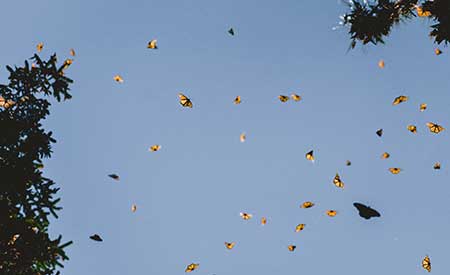Sri Lanka is an island in the Indian Ocean, famous for its beaches, tea and ancient temples. But few people know that this small island is a real hidden paradise for entomologists and anyone who is passionate about butterflies. More than 245 species of butterflies, of which about 23% are endemic, make Sri Lanka one of the richest points on the world map in this direction.

Why butterflies choose Sri Lanka
The island location, diverse climate zones – from tropical forests to mountainous areas – create ideal conditions for the existence of many species of butterflies. Even within one national park, you can find dozens of different representatives. The monsoon climate with regular rainfall contributes to year-round vegetation, which means a constant supply of food for caterpillars and nectar for adult butterflies.
Of the more than two hundred species of butterflies on the island, about sixty are found nowhere else in the world. Some of them, such as the Ceylon Tree Nymph or the impressive Sri Lankan Birdwing, are considered real treasures of Asian fauna. About twenty species are endangered and are included in protected programs, which underlines the ecological importance of the region.
Unique features of butterflies in Sri Lanka
The butterflies of the island amaze not only with their beauty, but also with their behavior. Some of them migrate around the island depending on the change of seasons and monsoons. Others have learned to imitate the coloring of poisonous species to avoid being eaten by predators. And some caterpillars enter into an alliance with ants: they guard the larvae, and in return they receive nutritious secretions – an amazing phenomenon of symbiosis.
Butterfly Spotting Tops
National Parks and Forest Reserves
If you dream of seeing butterflies in the wild, start with Sinharaja, a tropical forest listed as a UNESCO World Heritage Site. More than 80 species of butterflies have been recorded here, including rare endemics. Horton Plains Park has a cooler climate, but still has many species adapted to these conditions. The Knukles area is especially famous for its rich flora and fauna – a real treasure trove for naturalists.
Butterfly farms and eco-parks
Those who want not only to observe, but also to study the entire life cycle of butterflies, should visit eco-parks. In Kandy, there are several such centers where you can see how a caterpillar emerges from an egg, then a pupa and, finally, a butterfly. In the city forest of Udawattakele, right next to civilization, you can take unique photos and observe the behavior of butterflies in a semi-wild environment.
These farms are often looking for volunteers or people to work full-time. If you think you’re a perfect match for such an activity, visit the official website of farms and parks to see which vacancy is in the hottest position.
All in all, Sri Lanka is becoming increasingly attractive for digital nomads and freelancers. This is due to the low cost of living, good Internet infrastructure in tourist areas and, of course, stunning nature. Here you can work on your laptop in the morning and walk around the tropics with a camera in the afternoon in search of rare species.
If you want to combine your profession and hobby, you should consider the Jooble platform – here you can check for work from home Sri Lanka jobs. This is a convenient way to stay in touch with the professional sphere, while being in the heart of natural splendor.
How to observe butterflies: tips from an entomologist
The best time for observation is in the morning hours before 10:00, when the light is soft and the temperature is most comfortable for insect activity. Take binoculars with macro focus, a camera and a notebook – this will help you record your findings. Wear light clothes without strong scents: butterflies are very sensitive to odors and are easily frightened.
Ecological and scientific significance
Butterflies are not just a decoration of nature. They are the most important bioindicators of the state of ecosystems. Their disappearance can indicate serious environmental violations. This is why there are butterfly conservation programs in Sri Lanka, in which both local specialists and international organizations participate.
Final words
Sri Lanka is not just a resort or the tea capital of South Asia. It is a real paradise for everyone who loves butterflies, wants to understand their biology, observe rare species and contribute to the conservation of nature. And the opportunity to work remotely makes this country especially attractive for those who are looking for a balance between work and personal hobbies. Do not miss the chance to discover this hidden corner of the planet, where every morning can begin with the dance of hundreds of colorful wings against the backdrop of tropical landscapes.




